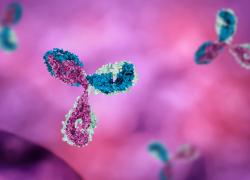
ASCO 2024 – J&J shifts to a new radiopharma dosing strategy
The group is keeping faith with the novel target KLK2.
The group is keeping faith with the novel target KLK2.

Johnson & Johnson made a splash before the ASCO meeting for the wrong reason, with its KLK2-targeting radiopharmaceutical project JNJ-69086420 linked with four patient deaths. But the group still believes in this target, on which it is going all-in despite a lack of other industry activity here.
“Everyone else is following; we are a leader,” Mark Wildgust, vice-president of global medical affairs for J&J oncology, told ApexOnco during ASCO. The company reckons it can mitigate toxicity with JNJ-6420 by capping the cumulative dose of radiation and using an adaptive dosing regimen, but he wouldn’t disclose when more data would come with this new approach.
Actinium + antibody
JNJ-6420 is a radiotherapy-MAb conjugate that uses a payload of actinium, an alpha emitter. Human kallikrein 2 (HK2 or KLK2) is “exquisitely expressed” on prostate cancer cells, Wildgust noted; in its phase 1 study, J&J is testing the project in metastatic castrate-resistant prostate cancer patients who’d received at least one androgen receptor pathway inhibitor such as Xtandi or Zytiga.
The trial initially tested the asset dosed at 50-300µCi, given every eight to 12 weeks.
The data being presented today, from 75 patients, found a 7% rate of interstitial lung disease, including two fatal cases. The other two deaths were due to Covid and “failure to thrive”, Wildgust said. Although these latter cases were deemed treatment-related, it seems possible that they might not have been caused by JNJ-6420.
However, Wildgust admitted that ILD was looking like a treatment-related toxicity, at least above a certain dose of JNJ-6420. Still, he contended that the side effect wasn’t down to the target.
The lead investigator, Dr Michael Morris of Memorial Sloan Kettering Cancer Center, told ApexOnco that ILD was likely related to cumulative radiation exposure.
“We didn’t see any ILD below 500µCi,” Wildgust said, adding the deaths came with cumulative doses of 750µCi and above. There were also cases of grade 3 and 4 thrombocytopenia at cumulative doses above 500µCi.
New dosing strategy
To combat these issues J&J plans to cap exposure at 500µCi, spread between either two 250µCi doses or a single 400µCi dose.
In addition the group is now testing an adaptive dosing regimen that involves monitoring a patient’s PSA levels, then redosing JNJ-6420 only if and when PSA levels rebound. Ultimately, one or two doses of JNJ-6420 should be enough, Wildgust believes. He points to a patient who received a single 250µCi dose and whose PSA levels were suppressed for over a year.
As for efficacy, J&J is now focused on 36 patients in the 250µCi dose cohort, where it saw a confirmed PSA50 response rate of 44% among 32 evaluable patients, and an ORR of 18% among 17 evaluable patients.
Wildgust rejected any notion that this efficacy was lacklustre. “This is a first-in-human study – the goal is to identify a dose.”
J&J now needs to show that its new dosing strategy works. In KLK2 the company also has a Car-T, JNJ-75229414, and a T-cell engager, JNJ-78278343. Wildgust believes that there could be room for more than one modality against this target in prostate cancer, echoing the approach J&J has taken in targeting BCMA.
If this is to play out J&J needs to convince that JNJ-6420’s toxicity isn’t caused by hitting KLK2.
3777













